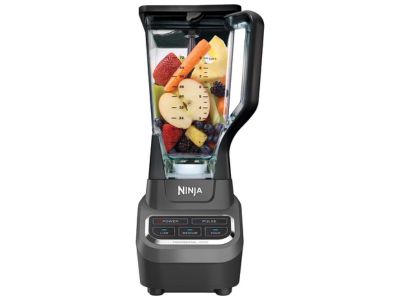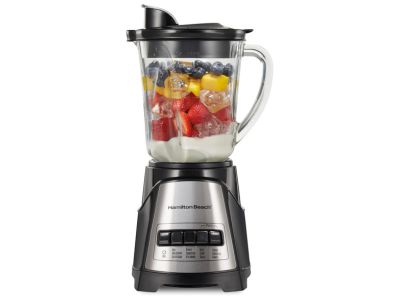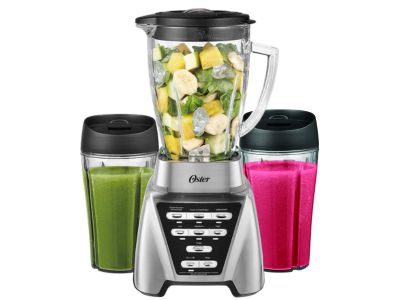- It is easy to confuse the functions of a Food processor with that of a blender. They share similar functions in some respects, but their functions differ entirely in other cases. The primary function of a blender is to puree and crush ice, while that of a Food Processor is primarily to shred, dice, and more. If you are still confused and comparing Food processor vs blender, note this. You can use a blender if your final product is something you can drink, while a Food Processor should be used if you pick it up with a fork.
- People often ask, ‘Can I use a blender instead of a food processor?’ The most straightforward answer is ‘Yes’, but only if you have to improvise. It is always better to use an appliance for its primary purpose. In other words, according to the manufacturer’s prescription. The blender recipes differ from those for Food processors. A blender may conveniently crush ice, but the same may not apply to a Food Processor.
Food processor vs blender
As highlighted above, Blenders and food processors are essential kitchen appliances that serve different purposes. They also have distinct features that make them suitable for various culinary tasks. Hence, if you must use both interchangeably, you better be careful not to abuse them. Note that there are blenders that have food-processing features too. A good example is the Ninja food processor and blender combo. No doubt Ninja is one of the best Food Processor brands out there. Here are the key differences between a blender and a food processor:
1. Functionality and Purpose:
Blender: Blenders are designed primarily for mixing and blending liquids. A good example is blenders for milkshakes. They excel at creating smooth textures and are ideal for making smoothies, shakes, soups, sauces, and beverages. This is why you will likely find blenders for ice-crushing rather than food processors serving the same function.
Food Processor: Food processors are versatile appliances that are great for chopping, slicing, and grating. Other uses of food processors include grating and kneading recipes. They are used for chopping vegetables, shredding cheese, and making nut butter. These are the major uses of a food processor. A mini food processor can handle these functions conveniently but is not the most robust blender.
2. Blade Design:
Blender: Blenders typically have sharp, angled blades at the bottom of the pitcher. These blades are designed to create a vortex that pulls ingredients downward, ensuring even blending.
Food Processor: Food processors have various blades and attachments, such as chopping blades, slicing discs, and shredding discs, which can be swapped out based on the task.
3. Texture and Consistency:
Blender: Blenders are excellent at creating smooth and consistent textures. They can blend liquids, fruits, and vegetables into silky-smooth concoctions.
Food Processor: Food processors can produce a range of textures, from coarse to fine. They are better suited for tasks requiring ingredients to maintain their textures, such as chopping vegetables for salsa.
4. Capacity:
Blender: Blenders usually have a larger capacity, making them suitable for preparing larger batches of drinks or soups.
Food Processor: Food processors come in various sizes, including mini food processors ideal for small tasks like chopping herbs or making small batches of sauces.
5. Liquid Handling:
Blender: Blenders are designed to handle liquids effectively, ensuring that ingredients blend smoothly without splattering.
Food Processor: While food processors can handle some liquids, they are not as well-suited for blending large quantities of liquids as blenders are.
6. Motor Power:
Blender: Blenders have potent motors that crush ice, blend frozen ingredients, and create smooth purees.
Food Processor: Food processors also have strong motors, but they are optimized for tasks that require less force, like chopping and slicing.
7. Attachments and Accessories:
Blender: Blenders generally have a pitcher, lid, and blending blades. Some high-end blenders may have additional features, like preset blending programs.
Food Processor: Food processors come with various attachments, including blades and discs, for various cutting and slicing needs.
In summary, blenders are best for creating smooth mixtures and liquids, while food processors excel at chopping, slicing, and preparing a variety of textures. Depending on your cooking style and the recipes you often prepare, having a blender and a food processor in your kitchen arsenal is the ideal solution.
Best Affordable Blender
Certainly! Here are the three best affordable blenders available on Amazon, along with short reviews for each:
1. Ninja Professional BL610 Blender

The Ninja Professional BL610 Blender offers powerful performance at an affordable price point. Its 1000-watt motor can easily crush ice, blend fruits, and create smoothies with a consistent texture. The extra-large 72-ounce pitcher allows you to make large batches of drinks, making it perfect for families or gatherings. It also has a 6-blade assembly that blends thoroughly. It is one of the best personal blenders for smoothies. In case you are wondering if you could use Ninja blenders as a food processor, you may want to check this out.
2. Hamilton Beach Power Elite Blender

The Hamilton Beach Power Elite Blender is a compact and efficient choice for users looking for an affordable blending solution. With its 700-watt motor and stainless steel blades, it can blend smoothies, shakes, sauces, and more. The 40-ounce glass jar is durable and easy to clean. This blender features a unique Wave-Action system that continuously pulls the mixture towards the blades for consistent blending results.
3. Oster Pro 1200 Blender with Glass Jar

The Oster Pro 1200 Blender stands out for its versatility and blending power. Equipped with a 1200-watt motor, it can handle various blending tasks, from smoothies to nut butter. What makes it unique is the included food processor attachment, which allows you to chop, slice, and shred ingredients. This isn’t a blender for kids, it is pretty powerful.
FAQs
1. What blender does Tropical Smoothie use?
Tropical Smoothie Cafe commonly uses the Blendtec brand of blenders to create signature smoothies and beverages.
2. Are hand blenders good for smoothies?
Hand blenders, also known as immersion blenders, are convenient for quick blending tasks, but they might not achieve the same smooth consistency as countertop blenders for complex smoothies with ice and fibrous ingredients.
3. Is a food processor the same as a blender?
No, they are not the same, as they specifically serve different functions. Hence, to understand the food processor vs blender debate, just know this, Food Processors are suitable for dicing, kneading, and grating, while blenders are suitable for pureeing and ice-crushing.
4. How much does a blender cost?
This depends mainly on the blender you wish to buy. You may refer to those listed above for guidance. Click on the link to find their prices on Amazon.
